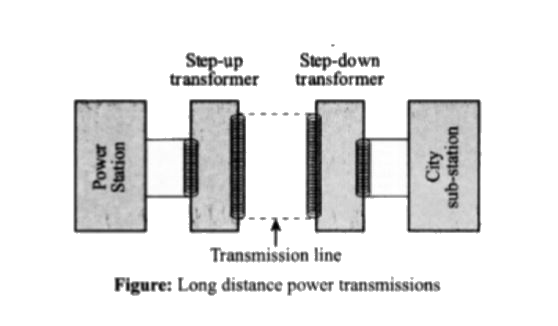A power transmission line feeds input power at 2300 V to a step-down transformer with its primary windings having 4000 turns. What should be the number of turns in the secondary in order to get output power at 230 V ?
Given, primary voltage, Vp=2300V
Secondary voltage, Vs=230V
Primary turns, Np=4000 turns
Here, we assume that the transformer is ideal. No power loss in the form of heat, etc.
Using the formula, VsVp=NsNp⇒2302300=Ns4000
Ns=400
Similar Questions
A power transmission line feeds input power at 2300 V to a step down trnasformer with it primary windings having 4000 turns. What should be the number of turns in the seconday windings in order to get output power at 230 V?
View SolutionA power transmission line feeds input power at 2300 V to a step down trnasformer with it primary windings having 4000 turns. What should be the number of turns in the seconday windings in order to get output power at 230 V?
View Solution
Knowledge Check
- Question 1 - Select One
A power transmission line feeds input power at 2400 V to a step down transformer with its primary windings having 4000 turns. What should be the number of turns in the secondary windings in order to get output power at 240 V?
A400B420C424D436 - Question 2 - Select One
A power transmission line feeds input power at 2400 V to a step down transformer with its primary windings having 4000 turns. What should be the number of turns in the secondary windings in order to get output power at 240 V?
A400B420C424D436 - Question 3 - Select One

Figure : Long distance power transmissions The large-scale transmission and distribution of electrical energy over long distances is done with the use of transformers. The voltage output of the generator is stepped-up. It is then transmitted over long distances to an area sub station near the consumers. There the voltage is stepped down. It is further stepped down at distributing sub-stations and utility poles before a power supply of 240 V reaches our homes.
A power transmission line feeds input power. at 2300 V to a step down transformer with its primary windings having 4000 turns. The number of turns in the secondary in order to get output power at 230 V are :A4B40C400D4000
Case study :
Read the following paragraph and answers the questions :

The large-scale transmission and distribution of electrical energy over long distances is done with the use of transformers. The voltage output of the generator is stepped-up. It is then transmitted over long distances to an area sub-station near the consumers. There the voltage is stepped down. It is further stepped down at distributing sub-stations and utility poles before a power supply of 240 V reaches our homes.
A power transmission line feeds input power at 2300 V to a step down transformer with its primary windings having 4000 turns. The number of turns in the secondary in order to get output power at 230 V areView Solution(a) Draw a labelled diagram of a step-up transformer. Obtain the ratio of secondary to primary voltage in terms of number of turns and currents in the two coils.
(b) A power transmission line feeds input power at 2200 V to a step-down transformer with its primary windings having 3000 turns. Find the number of turns in the secondary to get the power output at 220V.View SolutionA power transmission line feeds input power at 2200 V to a step-down transformer with its primary windings having 3000 turns. Find the number of turns in the secondary to get the power output at 220V.
View SolutionA power transmission line feeds input potential at 2200 V to a step down transformer with its primary winding having 3000 turns. Find the number of turns in secondary to get the power output at 220 V.
View Solution(a) Draw a labelled diagram of a stepup transformer. Obtain the ratio of secondary to primary voltage in terms of number of turns and currents in the two coils.
(b) A power transmission line feeds input power at 2200 V to a step-down transformer with its primary windings having 3000 turns. Find the number of turns in the secondary to get the power output at 220 V.View Solution

